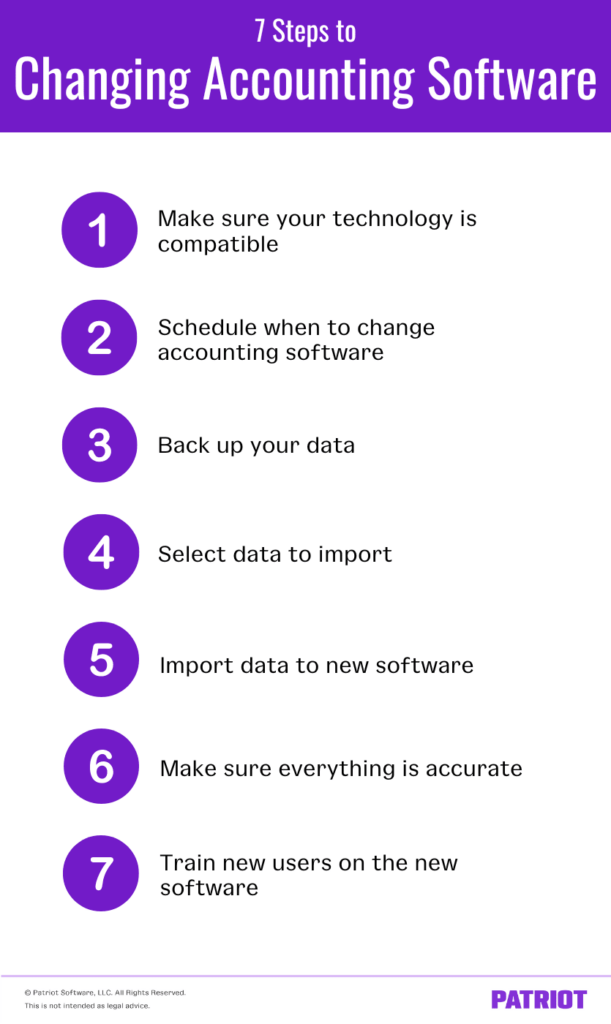As a small business owner, you already have enough on your plate. There’s no reason to hold on to accounting software that doesn’t meet your needs. Changing accounting software can make your business’s day-to-day run smoother than ever.
So, how do you do it? Read on for the scoop.
Reasons for changing accounting software
There’s no single reason for changing accounting systems. Depending on your business, there could be several reasons you’re thinking about how to switch accounting software.
Small business owners change accounting software for different reasons. Some of the possible reasons could include:
- Excel doesn’t cut it anymore
- Your old accounting software no longer meets your needs
- You want flexible software with multiple features
- The old software is too expensive
Once you’ve decided to change accounting software, you must find the software that fits your business needs.
Choosing the right accounting software
Before changing software, shop around to choose the right accounting software for your business.
To find the best software, ask questions like:
- Is the accounting software flexible?
- Will it fit my needs now and in the future?
- How does the software handle importing accounts?
- Is there a demo or trial I can use before I commit?
- How easy is it to get a hold of customer service?
Finding the perfect accounting software for your business is only half the battle. You still need to change from your old accounting system to your new one.

7 Steps to changing accounting software
Changing accounting software can be stressful and complicated. So, we’ve created a list of seven steps for changing your accounting software.
1. Make sure your level of technology is compatible
Make sure that your computing hardware fits with your new accounting software. There’s a chance that the new software will ask more from your IT infrastructure (e.g., hardware, internet speed, storage capabilities) than you realized. You may need to upgrade or optimize your technology (e.g., add more storage for desktop software).
If you need an upgrade and price is a concern, consider upgrading your technology over time rather than all at once.
2. Schedule when to change accounting software
Now that you have new software, you may already be dreaming about how good things will be after the switch. But, try not to act too quickly.
When switching accounting software, you need to set the right time to change between the old and new systems. To make things easier for yourself, consider making the switch at the end of an accounting period, such as the end of a fiscal quarter or year.
The beginning of a new year may be best. If you switch accounting systems at the beginning of a new year, you won’t have to carry over the year’s finances bit by bit. Instead, you can move the entire fiscal year at one time. A new year also means a clean start for your payroll reporting since it restarts at the end of the year.
But, a new year switch may not work for your business. You may find that changing accounting software mid-year or after a fiscal quarter suits your needs.
When thinking about scheduling a time to change your accounting software, consider:
- The part of the year that is slowest for your business: Choose a time of year that allows you to focus on your new accounting software.
- What your staff schedules look like for the year: Don’t switch accounting software when team members who handle your business’s books are out on PTO or vacation. You want those the switch impacts in-house so things run smoothly.
- How the switch might compete with other projects: Try to avoid other large projects. Moving accounting software can be complicated enough on its own. Don’t add additional tasks to the mix.
Keep in mind that the move isn’t going to happen overnight.
3. Back up your data
Before you switch accounting systems, make sure to back up your data. You don’t have to keep a hold of everything. For instance, you may get rid of inactive vendor, customer, and inventory item records from years ago. But, make sure you don’t lose any necessary information during the switch.
Be careful. When looking over your data, you may come across these common problems:
- It isn’t clear what’s a business transaction or a personal one
- You’ve classified financial transactions in a unique way that is difficult to understand
- It’s been a while since you reconciled accounts
4. Select data to import to your new software
Once you’ve cleaned up your data, you’ll know exactly what to back up and what to import. Some files you may want to import include:
- Chart of accounts
- Trial balance
- Customers
- Vendors
- Accounts
- Invoices
- Purchase orders
- Bills
Before you start the import process, you may want to export specific information into a CSV file. CSV files help move data between programs that don’t usually share information. If you can use CSV files to import information to your new accounting software, count your lucky stars—things just got easier.
5. Import data to your new software
Depending on your needs, there are two ways to import data from your old software to new software. You can:
- Do everything at once: If you decide to do everything at once, set aside time and create a checklist (or see if the provider has a checklist already for you) to help make sure you can focus and cover everything. But, be wary of the rush to finish importing your data. It’s better to be detail-oriented than make the switch as quickly as possible.
- Transition slowly: A transition period between the old and new software may take longer, but it could also help reduce the possibility of mistakes. Set up a schedule with specific deadlines.
6. Make sure everything is accurate
Now’s the time to make sure your transferred data is accurate and the software runs as expected.
First, make sure that the transferred data is accurate by reviewing the chart of accounts and running a trial balance.
Compare the same reports between the old and new accounting software. Do the two systems match up? If not, where did the mistakes happen—were they part of the migration process or simply a misunderstanding of the new software?
Next, run some tests on the new software to make sure:
- You understand how the system works
- The software works as expected
7. Train users on the new software
The best software is useless if no one understands how it works. Make sure you train yourself and those that have access. Don’t skip this step!
Properly onboarding the new system may be the most crucial step to making the switch as smooth as possible. Set an onboarding schedule to ensure that everyone is on the same page every step of the way.
Your new software’s customer support team may be integral in this step. There might be hiccups and times when you have to contact the support team.
Make sure to use any other options provided, like tutorials and FAQs. If you’ve picked the right software, there will be multiple ways to find the help you need.
Patriot’s accounting software is award-winning, easy to use, and based in the U.S.A. If you’re interested in what Patriot Software can offer your business, get your free trial today!
This is not intended as legal advice; for more information, please click here.


